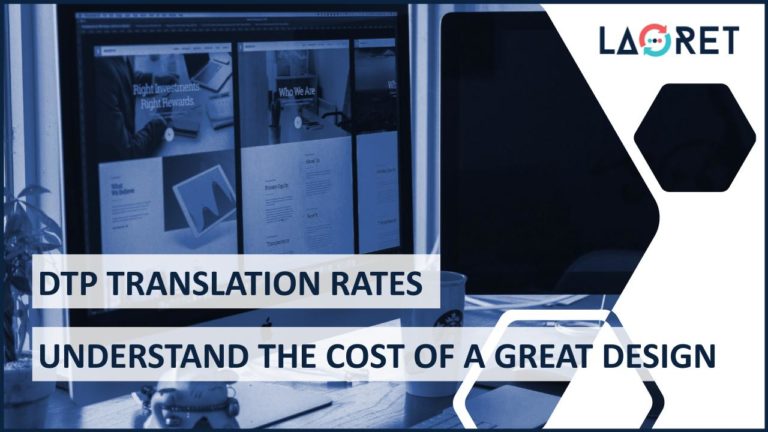DTP Translation Rates: Understand The Cost Of A Great Design
As mentioned in our blog, Multilingual Desktop Publishing (DTP): Go Global With The Right Design, Desktop Publishing Services can be complex and pose various challenges. This, of course, also means that the price tag can vary greatly depending on the project.
Learn about which factors determine DTP Translation Rates, what you can do to keep costs down, and how the services are calculated.
What Is Desktop Publishing Again?
We have thoroughly explored every aspect of Desktop Publishing Services before, but since we will be diving into the topic from a different angle here, let’s review what DTP services entail.
DTP refers to the processing and designing of content, usually graphic-heavy content, both for print and online publishing. The goal is that text and graphics blend in perfect harmony in the page layout. For this process to be fully optimized, DTP specialists leverage DTP software such as Adobe InDesign or Scribus.
And yes, we say specialists. Because while Open Source DTP programs such as Scribus allow for even a novice to take the shot at DTP, specialized knowledge gained through years of experience will still need to be applied. This is especially true for multilingual DTP used in the context of translation services, since every design will have to be effective for the intended locale and audience.
What Is The Cost Of Desktop Publishing Services?
In this blog, we will be discussing everything that has to do with DTP Translation Rates, from tips to help reduce the cost of your DTP translation project to how DTP translation rates are determined. If, however, you want to receive a specific quote, contact us through our Request A Quote Page, and get an estimate for your project as soon as possible.
How DTP Translation Rates Are Calculated
Going from the complexity of the service, you may have guessed that the way DTP services are charged can be quite complex as well. A simple translation service is charged per word, for example, but multilingual DTP also involves the perfect integration of text and images and information architecture. That is why there are specific aspects that fundamentally influence the eventual DTP price tag.
DTP Rates Per Page
While DTP Translation Rates can be offered based on the number of pages, it is not always a clear indication as to how much work will actually crawl into the project, due to the heavy amount of graphic design it can involve. For example, a single page could contain many graphics, illustrations, tablets, grids, and so on. This is why the DTP cost per page is usually implemented when dealing with lengthy documents that feature few images.
Hourly Rates
So, if we are involved in a project where there are a lot of graphics and illustrations involved, how is the rate best calculated? After all, images require more work than text and depending on how complex the images are and whether they will need to be adapted for the target locale, the workload can differ. That is why hourly rates are the most cost-effective method to use in this case.
DTP Rates Per Graphic
The DTP Process vs. DTP Translation Rates
3 Key Tips to Keep DTP Translation Rates Under Control: How to Save Money – and Time

What Is the Target Language?
The language that your materials will be translated into will determine the rate for the most part. Each language has its challenges, and DTP services are made all the more complex by languages that:
- Pose text expansion challenges. Some languages take up more space than others, and German, for example, will take up about 3 times more space than English. This will inevitably impact the design.
- Are not based on the Latin alphabet, such as Arabic, Russian, and Japanese, which follow their own linguistic rules and are generally more complex than western European languages.
- Are not based on the Latin alphabet and written in a different direction. Arabic, for example, is written from right to left, while Japanese is written from top to bottom. Here too, the design will need to be adjusted to fit the language.
What Type of Material Do You Have?
Are you translating a website or app? Or just a couple of documents? It is important to remember that graphics-heavy projects such as apps, will have a higher cost because of the number of DTP experts that may be assigned to the project, and the time it will take to complete it.
3. Consider Your Scheduled Timeline
You will most likely want your project to be finished before a certain time, right? After all, both quality and speed matter in today’s business climate. That is why in the translation industry, rush fees are commonly applied for the projects that will need to be completed before a certain time. While this will demand more from an LSP in terms of hours and resources, you can make sure that you are doing what you can to speed up the process and cut down on production time.
Make Translation Your Goal From The Start
We often receive requests for website translation, adapting packaging for different regions, or even the localization of marketing materials, where no adaptations have been made to actually support the translation process. And to many clients’ surprise, this is not actually that complicated and yet makes a world of difference. Keep the following points in mind if you want to keep turnaround time and costs down.
- Avoid hard coding your images and graphics. When you hardcode the image dimension, you are limiting the image to the source text size. Depending on the text expansion and contraction, however, the localized images will need to be redesigned in different sizes.If you deliver your image in this way, it will be hectic for either or both the translator to match the translation with the source text’s size (which is oftentimes unrealistic) and the DTP specialist to manually adjust/redesign the localized image, which will take up far more time than is necessary.
- Avoid using tabs since they can prevent the content from adapting to a new layout. Instead, create tables and text boxes. This way, text expansion or contraction can more easily be accommodated, and the content can more easily flow.
- Avoid splitting phrases and keep your lines complete. Most vendors leverage Translation CAT Tools, and a break in the line can be read as the end of the sentence.
- If you are making use of index markers, make sure to place them as close to the intended reference, ideally next to the word or the beginning/ending of the sentence.
Once you are ready to reach out to a qualified vendor, you will still need to follow some best practices to boost the efficiency of your documents, mainly:
- Provide reference material to communicate exactly what you would like the finished product to look like. This can include specific guidelines of your brand, such as a style guide with an overview of your stylistic preferences to maintain your brand voice, but also visuals by competitors and thought leaders where you indicate which features you would like to be integrated in your own unique style and brand.
- You should also share the original files of any visual materials you would like to see integrated into the translated designs. If your designs include a logo, for example, send it along separately in the most commonly used formats such as AI or EPS as used in Illustrator, and PNG.
Conclusion
So, how much will you pay for your Multilingual DTP services? There are several factors that go into DTP translation rates. Do you have many graphics that will need localizing and formatting? Have you selected any languages that may be challenging because of their scripture, expansion properties, or direction? And don’t forget, have you implemented all of our tips to thoroughly prepare your documents for DTP and localization? Long story short, be prepared!
At Laoret, we boast years of experience in multilingual DTP and leverage native linguists, designers, and engineers who all work together within a highly optimized TMS.
Our 24/7 availability and commitment to designing our own tools, mean that we can offer high-quality services at competitive rates. Contact Us for a quick quote!


